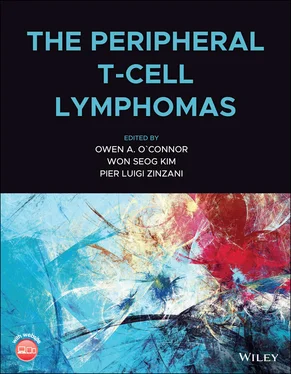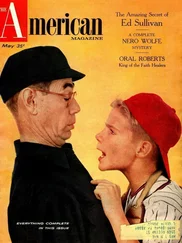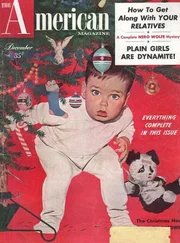9 9 Swerdlow, S.H., Campo, E., Harris, N.L. et al. (2017). WHO Classification of Tumours of Haematopoietic and Lymphoid Tissues, (rev. 4e). Lyon: International Agency for Research on Cancer.
10 10 Vose, J., Armitage, J., and Weisenburger, D. (2008). International peripheral T‐cell and natural killer/T‐cell lymphoma study: pathology findings and clinical outcomes. J Clin Oncol 26 (25): 4124–4130.
11 11 Rüdiger, T., Weisenburger, D.D., Anderson, J.R. et al. (2002). Peripheral T‐cell lymphoma (excluding anaplastic large‐cell lymphoma): results from the Non‐Hodgkin’s Lymphoma Classification Project. Ann Oncol 13 (1): 140–149.
12 12 Bellei, M., Chiattone, C.S., Luminari, S. et al. (2012). T‐cell lymphomas in South America and Europe. Rev. Bras. Hematol. Hemoter. 34: 42–47.
13 13 National Cancer Institute. (2019). SEER Cancer Statistics Review (CSR) 1975–2016. https://seer.cancer.gov/archive/csr/1975_2016(accessed 11 August 2020).
14 14 Armitage, J.O. and Weisenburger, D.D. (1998). New approach to classifying non‐Hodgkin’s lymphomas: clinical features of the major histologic subtypes. Non‐Hodgkin’s Lymphoma Classification Project. J Clin Oncol 16: 2780–2795.
15 15 Abramson, J.S., Feldman, T., Kroll‐Desrosiers, A.R. et al. (2014). Peripheral T‐cell lymphomas in a large US multicenter cohort: prognostication in the modern era including impact of frontline therapy. Ann Oncol 25: 2211–2217.
16 16 Ellin, F., Landström, J., Jerkeman, M., and Relander, T. (2014). Real‐world data on prognostic factors and treatment in peripheral T‐cell lymphomas: a study from the Swedish Lymphoma Registry. Blood 124: 1570–1577.
17 17 Abouyabis, A.N., Shenoy, P.J., Lechowicz, M.J., and Flowers, C.R. (2008). Incidence and outcomes of the peripheral T‐cell lymphoma subtypes in the United States. Leuk Lymphoma 49: 2099–2107.
18 18 Adams, S.V., Newcomb, P.A., and Shustov, A.R. (2016). Racial patterns of peripheral T‐cell lymphoma incidence and survival in the United States. J Clin Oncol 34: 963–971.
19 19 Weisenburger, D.D., Savage, K.J., Harris, N.L. et al. (2011). Peripheral T‐cell lymphoma, not otherwise specified: a report of 340 cases from the International Peripheral T‐cell Lymphoma Project. Blood 117: 3402–3408.
20 20 Wang, S.S., Flowers, C.R., Kadin, M.E. et al. (2014). Medical history, lifestyle, family history, and occupational risk factors for peripheral T‐cell lymphomas: the InterLymph Non‐Hodgkin Lymphoma Subtypes Project. J Natl Cancer Inst Monogr 2014 (48): 66–75.
21 21 Cahoon, E.K., Pfeiffer, R.M., Wheeler, D.C. et al. (2015). Relationship between ambient ultraviolet radiation and non‐Hodgkin lymphoma subtypes: a U.S. population based study of racial and ethnic groups. Int J Cancer 136 (5): E432–E441.
22 22 Grogg, K.L., Attygalle, A.D., Macon, W.R. et al. (2005). Angioimmunoblastic T‐cell lymphoma: a neoplasm of germinal‐center T‐helper cells? Blood 106: 1501–1502.
23 23 Krenacs, L., Schaerli, P., Kis, G., and Bagdi, E. (2006). Phenotype of neoplastic cells in angioimmunoblastic T‐cell lymphoma is consistent with activated follicular B helper T cells. Blood 108: 1110–1111.
24 24 Rudiger, T., Weisenburger, D.D., Coiffier, B. et al. (2008). Angioimmunoblastic T‐cell lymphoma: a report from the international peripheral T‐cell lymphoma project. Ann Oncol 19 (Suppl 4): 119.
25 25 Morton, L.M., Wang, S.S., Devesa, S.S. et al. (2006). Lymphoma incidence patterns by WHO subtype in the United States, 1992–2001. Blood 107: 265.
26 26 de Leval, L., Parrens, M., Le Bras, F. et al. (2015). Angioimmunoblastic T‐cell lymphoma is the most common T‐cell lymphoma in two distinct French information data sets. Haematologica 100 (9): e361–e364.
27 27 National Cancer Instutite. Surveillance, Epidemiology, and End Results (SEER) Program. http://www.seer.cancer.gov[updated based on the November 2013 submission] (accessed 11 August 2020).
28 28 Ohsaka, A., Saito, K., Sakai, T. et al. (1992). Clinicopathologic and therapeutic aspects of angioimmunoblastic lymphadenopathy‐related lesions. Cancer 69: 1259–1267.
29 29 Pautier, P., Devidas, A., Delmer, A. et al. (1999). Angioimmunoblastic‐like T‐cell non Hodgkin’s lymphoma: outcome after chemotherapy in 33 patients and review of the literature. Leuk Lymphoma 32: 545–552.
30 30 Siegert, W., Nerl, C., Agthe, A. et al. (1995). Angioimmunoblastic lymphadenopathy (AILD)‐type T‐cell lymphoma: prognostic impact of clinical observations and laboratory findings at presentation. The Kiel Lymphoma Study Group. Ann Oncol 6: 659–664.
31 31 Federico, M., Rudiger, T., Bellei, M. et al. (2013). Clinicopathologic characteristics of angioimmunoblastic T‐cell lymphoma: analysis of the international peripheral T‐cell lymphoma project. J Clin Oncol 31: 240–246.
32 32 Khan, G., Norton, J.A., and Slavin, G. (1993). Epstein‐Barr virus in angioimmunoblastic T‐cell lymphomas. Histopathology 22 (2): 145–149.
33 33 Smith, A., Crouch, S., Lax, S. et al. (2015). Lymphoma incidence, survival and prevalence 2004‐2014: sub‐type analyses from the UK’s Haematological Malignancy Research Network. Br J Cancer 112 (9): 1575–1584.
34 34 Al‐Hamadani, M., Habermann, T.M., Cerhan, J.R. et al. (2015). Non‐Hodgkin lymphoma subtype distribution, geodemographic patterns, and survival in the US: a longitudinal analysis of the National Cancer Data Base from 1998 to 2011. Am J Hematol 90: 790–795.
35 35 Guru Murthy, G.S., Hamadani, M., Bhatt, V.R. et al. (2017). Systemic anaplastic lymphoma kinase‐positive anaplastic large cell lymphoma: a population‐based analysis of incidence and survival. Clin Lymphoma Myeloma Leuk 17: 201–206.
36 36 Savage, K.J., Harris, N.L., Vose, J.M. et al. (2008). ALK– anaplastic large‐cell lymphoma is clinically and immunophenotypically different from both ALK+ ALCL and peripheral T‐cell lymphoma, not otherwise specified: report from the International Peripheral T‐Cell Lymphoma Project. Blood 111: 5496–5504.
37 37 Falini, B., Pileri, S., Zinzani, P.L. et al. (1999). ALK+ lymphoma: clinico‐pathological findings and outcome. Blood 93: 2697–2706.
38 38 Fallah, M., Liu, X., Ji, J. et al. (2014). Autoimmune diseases associated with nonHodgkin lymphoma: a nationwide cohort study. Ann Oncol 25 (10): 2025–2030.
39 39 Herling, M., Rassidakis, G.Z., Jones, D. et al. (2004). Absence of Epstein‐Barr virus in anaplastic large cell lymphoma: a study of 64 cases classified according to World Health Organization criteria. Hum Pathol 35: 455–459.
40 40 Castillo, J.J., Beltran, B.E., Bibas, M. et al. (2011). Prognostic factors in patients with HIV‐associated peripheral T‐cell lymphoma: a multicenter study. Am J Hematol 86: 256–261.
41 41 Olack, B., Gupta, R., and Brooks, G.S. (2007). Anaplastic large cell lymphoma arising in a saline breast implant capsule after tissue expander breast reconstruction. Ann Plast Surg 59: 56–57.
42 42 Lazzeri, D., Agostini, T., Bocci, G. et al. (2011). ALK‐1‐negative anaplastic large cell lymphoma associated with breast implants: a new clinical entity. Clin Breast Cancer 11: 283–296.
43 43 de Jong, D., Vasmel, W.L., de Boer, J.P. et al. (2008). Anaplastic large‐cell lymphoma in women with breast implants. JAMA 300 (17): 2030–2035.
44 44 Brody, G.S., Deapen, D., Taylor, C.R. et al. (2015). Anaplastic large cell lymphoma occurring in women with breast implants: analysis of 173 cases. Plast Reconstr Surg 135: 695–705.
45 45 Picard, F.J., Coulthart, M.B., Oger, J. et al. (1995). Human T‐lymphotropic virus type 1 in coastal natives of British Columbia: phylogenetic affinities and possible origins. J Virol 69: 7248–7256.
46 46 Hjelle, B., Khabbaz, R.F., Conway, G.A. et al. (1994). Prevalence of human T cell lymphotropic virus type II in American Indian populations of the southwestern United States. Am J Trop Med Hyg 51: 11–15.
Читать дальше












